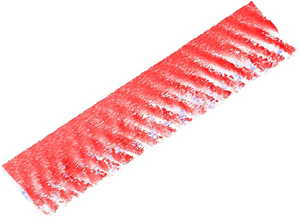Article contents
A secondary modulation mechanism for aerofoil tonal self-noise generation
Published online by Cambridge University Press: 06 June 2022
Abstract

Acoustic emission of a NACA 0012 aerofoil is investigated over a range of free-stream velocities. Acoustic spectra show a dominant tone and two sets of weaker side tones characterised by different frequency intervals. The frequency of the dominant tones in the acoustic spectra varies with velocity in a ladder-type structure. With increasing Reynolds number, the spectrum becomes progressively more broadband in nature. Through synchronised particle image velocimetry and acoustic measurements, the aeroacoustic noise generation mechanisms, resulting in different spectral characteristics and modulation types, are further investigated. A separation bubble and related significant velocity fluctuations are observed on the pressure side. Pressure side velocity spectra show characteristics similar to the acoustic ones, whereas velocity spectra on the suction side feature broadband characteristics. These findings confirm that noise emission is dominated by pressure side events for the Reynolds number range of this study, i.e.  $2 \times 10^{5}$–
$2 \times 10^{5}$– $7 \times 10^{5}$. As the acoustic emission is defined by coherent flow structures, the proper orthogonal decomposition method is adopted to facilitate the understanding of the relation between the complex flow field and acoustic emission. Side tones in the acoustic spectra are attributed to two different modulation mechanisms in the aeroacoustic source region near the trailing edge. By aligning the sound pressure time history and the time coefficients of the dominant modes, the primary modulation of the dominant tone is found to be related to the amplitude modulation of the high-frequency velocity fluctuations associated with the acoustic feedback loop. A secondary modulation is attributed to periodic variation of the separation bubble and, therefore, variation in the roll-up of the shear layer, which results in a modulation of the amplitude of the velocity fluctuations associated with the convecting vortices at the trailing edge.
$7 \times 10^{5}$. As the acoustic emission is defined by coherent flow structures, the proper orthogonal decomposition method is adopted to facilitate the understanding of the relation between the complex flow field and acoustic emission. Side tones in the acoustic spectra are attributed to two different modulation mechanisms in the aeroacoustic source region near the trailing edge. By aligning the sound pressure time history and the time coefficients of the dominant modes, the primary modulation of the dominant tone is found to be related to the amplitude modulation of the high-frequency velocity fluctuations associated with the acoustic feedback loop. A secondary modulation is attributed to periodic variation of the separation bubble and, therefore, variation in the roll-up of the shear layer, which results in a modulation of the amplitude of the velocity fluctuations associated with the convecting vortices at the trailing edge.
JFM classification
Information
- Type
- JFM Papers
- Information
- Copyright
- © The Author(s), 2022. Published by Cambridge University Press
References
- 15
- Cited by


